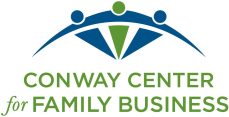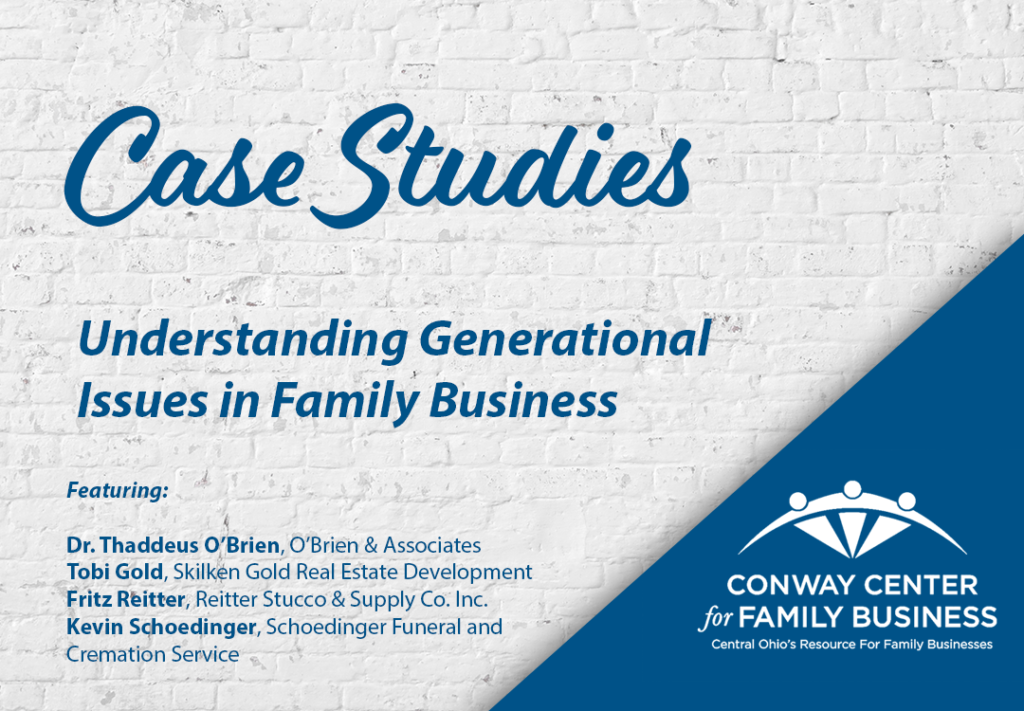Featuring:
Dr. Thaddeus O’Brien, O’Brien & Associates
Tobi Gold, Skilken Gold Real Estate Development
Fritz Reitter, Reitter Stucco & Supply Co. Inc.
Kevin Schoedinger, Schoedinger Funeral and Cremation Service
Understanding Generational Issues in Family Business
The generations that launched many of our family businesses are living longer, resulting in more generations being involved in family business at the same time. This creates more cross-generational issues in family business than ever before. While any family business leader wants future generations of the family to continue the legacy of the family business, it can be difficult to simultaneously integrate multiple generations into day-to-day business, provide sufficient personal and professional growth opportunities, and manage leadership transition.
Further, we are learning that each generation carries different goals and motivations.
Baby Boomers (born 1943-1960) are primarily motivated by getting ahead and have a love/hate relationship with authority. They are generally very personable and do well with face-to-face communication.
Gen Xers (born 1961-1979) are motivated by rewarding challenges and thrive on direct communication. They are often suspicious of authority and use computers as their primary communication tool.
Finally, millennials, also known as Gen Y (born 1981 – 1996), seek a work/life balance and are motivated to give back to their communities. They gravitate to working in collaboration and using electronic and digital devices to complete work. They are often a source of new ideas and the instigators of change in an organization.
According to Dr. Thaddeus O’Brien, “It would be advantageous for business if family business leaders were able to recognize and value the strengths of each generation.”
Being the Boss: Stepping into Family Business Leadership
Many Conway Center for Family Business leaders learn that stepping into a leadership role in the family business is not exactly what they had envisioned. One of the most difficult challenges is learning to control what can be controlled, and not letting things outside of a business’s control take up too much headspace. For example, spending excessive time worrying about broad economic trends or what competitors are doing, could be problematic if it takes time away from resolving issues within the company. Family business leaders can develop strategic plans to deal with broad issues, like the economy, to help them rest a bit easier.
This is important because there is already enough stress that comes with leadership. New leaders can be kept up at night as they worry about finances, tough staffing and personnel decisions, as well as balancing increased work hours with their own family responsibilities.
Tobi Gold understands the personal dynamics of working with a spouse and family members. “My husband invited me to get involved in the business because we had complimentary skills. In the beginning, we had a lot of things to work through at every level and we had to get used to working together. It was tough, but thankfully, we were able to move forward and are now growing and flourishing.”
Evolving the Family Business after Succession
It can be difficult to decide what to keep, what to toss and what to change when you assume a leadership role. Fritz Reitter recommends getting all your agreements in place first to avoid conflict and arguments later. “We try to keep communication high because if you do not, misperceptions or thoughts can create issues later.”
Kevin Schoedinger adds that “it can be hard to change a business when you’ve grown up in it. It may be helpful to have someone else provide a fresh look, so you are not just resting on your company’s laurels.”
Trust from Family and Non-Family in the Family Business
Changing the older generation’s perception of younger generations as they step into leadership roles can be challenging. Schoedinger says, “It is difficult for your family and long-time company employees to quit looking at you as the four-year old who was running around at the business years ago.”
Echoing that sentiment, Gold mentions, “I had read a lot about succession planning and the recommendation that children should work outside the family business at least five to seven years before coming into the business. However, we came across a need and our son had only been working outside the business for three years. I felt it was too soon because of what I had read, but a few outside consultants calmed me down and explained how it could work because we had need, he had the skills, willingness, and desire.”
Keeping the Passion Across Generations
Launching a family business can be an exhilarating process, often driven by a founder’s passion to solve a unique challenge in their community. At the time of succession, however, family business owners often worry if the younger generations will bring that same enthusiasm. Older generations should understand that passions and motivations can take many forms that ultimately benefit the business, as described by Conway Center for Family Business members.
Having parents around during times of transition is a privilege for younger generations. Older generations are still as passionate about the business as ever and can make significant contributions if the younger generations need experience-based insight. And, without as many financial pressures on their shoulders anymore, parents are more able to fully enjoy the business, and their personal relationships, without as many highs and lows that come with ownership, leading to a “calming” effect throughout the business.
Engaging Younger Generations in your Family Business
Many family business leaders in Central Ohio agree that parents should help their children find something they are passionate about, whether that involves them in the family business or not. Further, the firstborn may not always be the best choice for a successor. Parents will need to evaluate the interests and skills of each individual before choosing a successor.
Reitter believes, “If you have the right people in the right seats, the entire company benefits. If you have somebody in the wrong seat, an individual may benefit, but the rest will not work, and eventually that can be a hinderance.”
Schoedinger notes that having a successful business can be a positive thing because there is not as much pressure for all family members to be a part of the business. He says this can also put added pressure on that generation because they are concerned about living up to the standards set by the previous generations.
Generational issues can be an inseparable, and awkward, part of running a family business, but that doesn’t mean you should put off planning. Starting the conversation and showing persistence in having the conversation is key. Once started, both generations should keep the ball rolling by taking appropriate follow-up steps. Once the process is completed, control of the family business will successfully move to the next generation and the family business and family legacy will continue!
Learn more about topics like succession planning, planning for retirement, and generational issues with family business by reading a Conway Center for Family Business eBook.
About the Conway Center
The Conway Center for Family Business is Central Ohio’s resource for educational programs, resources and networking opportunities to support the growth and success of family-owned businesses. The Center celebrates the successes of family-owned businesses at its annual awards program and offers peer group opportunities for next-generation leaders, family business leaders, and women family business owners. The organization includes more than 200 family-owned businesses from Central Ohio that employ more than 35,000 individuals.
Learn more about Conway Center for Family Business membership.

